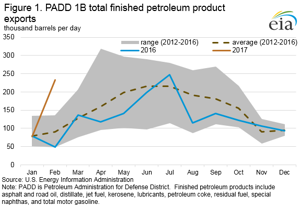EIA: Petroleum product exports from Central Atlantic US unusually high in February
Exports of finished petroleum products from the Petroleum Administration of Defense District (PADD) 1B, which comprises the US Central Atlantic states (Delaware, District of Columbia, Maryland, New Jersey, New York and Pennsylvania), reached a record high for the month of February, as petroleum product prices in that region weakened compared with prices in the rest of the Atlantic Basin region. In February, exports of finished petroleum products from PADD 1B were 232,934 bpd, more than 2.5 times greater than the previous 5-yr average. Distillate and total motor gasoline, the two most consumed petroleum products globally, were among the products that showed an increase in exports.
With 22% of Northeast households using distillate for home heating, a higher proportion than in any other US region, distillate is generally imported into the Northeast during the winter months. However, because temperatures were warmer-than-normal in February, distillate exports from PADD 1B totaled 103,257 bpd, a record high for the month. Of the total distillate exported by PADD 1B in February, Europe received 50%, Central and South America received 28%, and Africa received the remaining 22%. Total motor gasoline exports from PADD 1B were 31,431 bpd in February, compared with just over 1,000 bpd on average over the previous five years. Nearly all of the gasoline exports from PADD 1B went to Africa.
The atypical volume of petroleum product exports from the Central Atlantic states in February arose because the region’s prices of these petroleum products were more competitive than normal compared with other Atlantic Basin product prices, making exports to countries in Africa, Central and South America, and Europe more attractive. In the beginning of 2017, gasoline and ultra-low sulfur diesel (ULSD) futures prices in New York Harbor weakened against gasoline and ULSD spot prices in Northwest Europe, a major hub in the Atlantic Basin market for trade. Comparing futures prices with spot prices helps to take into account shipping transit time.
The Northwest Europe gasoline spot price exceeded the reformulated blendstock for oxygenate blending (RBOB) front-month futures price on the New York Mercantile Exchange (NYMEX) in February, the first such premium for that month since at least 2010. The price spread between the NYMEX ULSD front-month futures price and the Northwest Europe ULSD spot price declined to the lowest level for the month of February since the underlying commodity of the NYMEX ULSD futures contract switched to a distillate with lower sulfur specifications in May 2013.
The gasoline price premium in Northwest Europe in February likely reflected differences in inventory growth between Europe and the United States. Increased gasoline exports from Europe to Africa and other regions contributed to a year-over-year decline in gasoline stocks in the trading hub of Amsterdam-Rotterdam-Antwerp (ARA) in Northwest Europe in February. In contrast, total gasoline stocks reached a record high on Feb. 10 in the Central Atlantic and New England states (PADDs 1A and 1B). US gasoline consumption in January and February declined from the same period in 2016.
Distillate stocks in the ARA region have been below last year’s level for several months. In PADDs 1A and 1B, however, distillate stocks were above last year’s level in February, likely because of decreased demand associated with warmer temperatures. In Europe, colder-than-normal temperatures, higher distillate exports from the region, and an accelerated expansion of the manufacturing sector in the Eurozone area may have contributed to lower distillate inventories than last year and stronger Northwest Europe ULSD spot prices compared with NYMEX ULSD front-month futures prices than in recent years.
US average regular gasoline and diesel prices fall
The US average regular gasoline retail price fell four cents from the previous week to $2.41 per gallon on May 1, up 17 cents from the same time last year. The Midwest price fell seven cents to $2.29 per gallon, the East Coast and Gulf Coast prices each fell three cents to $2.39 per gallon and $2.20 per gallon, respectively, and the West Coast and Rocky Mountain prices each fell one cent to $2.88 per gallon and $2.40 per gallon, respectively.
The US average diesel fuel price fell over one cent to $2.58 per gallon on May 1, 32 cents higher than a year ago. The Gulf Coast price fell two cents to $2.44 per gallon, the West Coast price fell over one cent to $2.86 per gallon, and the East Coast and Midwest prices each fell one cent to $2.62 per gallon and $2.52 per gallon, respectively. The Rocky Mountain price increased less than one cent to $2.67 per gallon.
Propane inventories increase slightly
US propane stocks increased slightly, remaining virtually unchanged at 39.7 million barrels as of April 28, 2017, 32.2 MMbbl (44.8%) lower than a year ago. Midwest and East Coast inventories decreased by 0.2 MMbbl and 0.1 MMbbl, respectively, while Gulf Coast and Rocky Mountain/West Coast inventories each increased by 0.1 million barrels. Propylene non-fuel-use inventories represented 7.5% of total propane inventories.







Comments